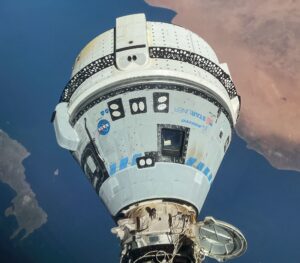CAPE CANAVERAL, Fla. (AP) — SpaceX will use a powerful, guided capsule to push the International Space Station out of orbit after the sprawling laboratory’s time runs out.
NASA and Elon Musk’s company outlined a plan Wednesday to burn up the space station on re-entry and sink what’s left in the ocean, ideally in early 2031, when it reaches the 32-year mark. The space agency ruled out other options, such as dismantling the station and bringing everything home or handing the keys over to someone else.
NASA gave SpaceX a $843 million contract to bring down the station, the largest structure ever built off-planet.
Here is a brief description of the job and the challenges ahead:
Why get rid of the space station?
The space station is already showing signs of age. Russia and the US launched the first units in late 1998, and the astronauts moved in two years later. Europe and Japan added their own segments, and Canada provided robotic arms. By the time NASA’s shuttles retired in 2011, the station had grown to the size of a football field with a mass of nearly 1 million pounds (430,000 kilograms). NASA thinks the station will last until at least 2030. The goal is for private companies to launch their own space stations by then, with NASA serving as one of many customers. This strategy — which is already in place to deliver cargo and crew to the station — will free NASA to focus on traveling to the Moon and Mars. NASA may also decide to extend the life of the station if there are no commercial outposts there yet. The aim is to have overlap so that research is not interrupted.
Why not bring it back to Earth?
NASA considered dismantling the space station and hauling the pieces back to Earth or letting private companies salvage the parts for their own planned missions. But the station was never intended to be disassembled in orbit, according to NASA, and any such effort would be expensive and risky for the astronauts who would handle the disassembly. Also, there is no spacecraft as big as NASA’s old shuttles to take it all down. Another option would be to raise the empty station to a higher, more stable orbit. But this too was rejected given logistical problems and the increased risk of space junk.
How will it be taken down?
Visiting spacecraft periodically boost the space station so that it remains in orbit at an altitude of approximately 260 miles (420 kilometers). Otherwise, it would get lower and lower until it plunged uncontrollably from orbit. NASA wants to ensure a safe re-entry over a remote stretch of the South Pacific or possibly the Indian Ocean, so that means launching a spacecraft that will dock with the station and guide it to a watery grave. NASA expects some denser pieces, ranging in size from a microwave oven to a sedan, to survive in a narrow 1,200-mile (2,000-kilometer) debris field. NASA and its partners considered using three Russian supply ships for the job, but a more robust ship was needed. The call went out to industry, and in June SpaceX won the contract for the deorbit vehicle.
What will the spacecraft look like for exiting orbit?
SpaceX plans to use a regular Dragon capsule — the kind that carries supplies and astronauts to the space station — but with a much larger trunk that houses a record 46 engines and more than 35,000 pounds (16,000 kilograms) of fuel. SpaceX’s Sarah Walker said the challenge will be creating a spacecraft powerful enough to guide the space station while withstanding the pull and forces of increased atmospheric drag during the final descent. This spacecraft will require an especially powerful rocket just to get to orbit, according to NASA. The capsule will be launched 1 1/2 years before the planned shutdown of the station. The astronauts will still be on board as it gradually descends. Six months before the destruction of the station, the crew will leave the ship and return home. Once the station has fallen to about 137 miles (220 kilometers), Dragon will bring it down four days later.
Has this been done before?
NASA’s first space station, Skylab, crashed in 1979, showering debris over Australia and the surrounding Pacific Ocean. The space agency had hoped that one of the first space shuttle crews could attach a rocket to control Skylab’s descent or boost its orbit. But the shuttle wasn’t ready until then, with its first flight not until 1981. Ground controllers were able to send Skylab into a slow descent toward the Indian Ocean. But some pieces also landed in Western Australia. Russia has more experience with incoming space stations. Mir operated for 15 years before being directed into a fiery re-entry over the Pacific Ocean in 2001. Before that, several Salyut stations bit the dust.
Will anything be saved?
NASA wants to return some small items from inside the space station for museum display, such as the ship’s bell and logs, patch panels and other memorabilia. They may land in SpaceX’s supply ships within the last year or two. “Unfortunately, we can’t bring home really, really big stuff,” NASA’s Ken Bowersox said. “The emotional part of me would like to try to salvage a little bit,” but the most practical approach is to knock everything down in one devastating blow, he said.
___
The Associated Press Health and Science Division is supported by the Science and Education Media Group of the Howard Hughes Medical Institute. AP is solely responsible for all content.


